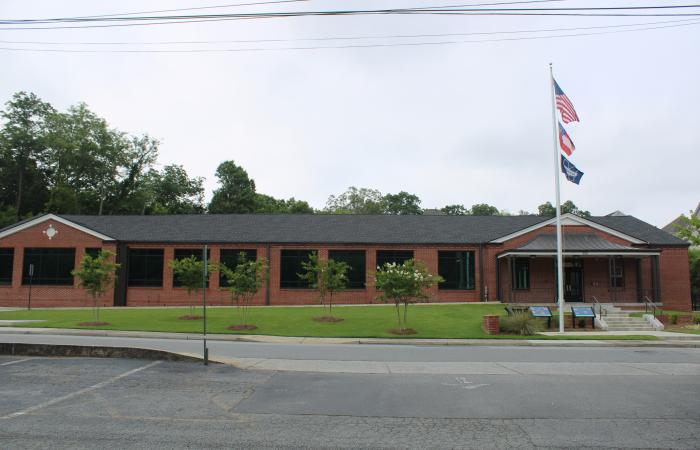Georgia adds four listings to Georgia Register for Historic Places

Georgia added four new listings to the Georgia Register of Historic Places, continuing to highlight the state’s wide variety of historic resources.
The Georgia National Register Review Board approved these listings on November 3, 2023. This group evaluates state nominations for the National Register prior to their submission to the National Park Service for listing on the National Register of Historic Places.
The new Georgia Register listings include:
- Brown’s Mill Battlefield, Newnan, Coweta County
- Dooly County Campground, Vienna, Dooly County
- Fountain Hill, Conyers, Rockdale County
- Lemon Street School, Marietta, Cobb County
Many of these National Register nominations were spurred by community action and research, making them integral to the Georgia Department of Community Affairs’ mission to build strong, vibrant communities.
The Historic Preservation Division hopes sharing this information will encourage more historic property preservation through public awareness, as well as foster appreciation of its impact on our social and economic lives.
Information on each the newest listings is below:
Brown’s Mill Battlefield, Newnan, Coweta County
The Brown’s Mill Battlefield is significant to Georgia’s military history as the Union and Confederate armies clashed there during the American Civil War. The Battle of Brown’s Mill was one in a series of Union setbacks, marking a major turning point in the Atlanta Campaign.
On July 30, 1864, while attempting to destroy the remaining Confederate railroads supplying Atlanta, Union forces – under the direction of Brigadier General Edward M. McCook – sought to bypass Newnan and the Confederate soldiers occupying the city. Pursuing Confederates, commanded by Major General Joseph Wheeler, caught up with McCook’s forces at the intersection of today’s Millard Farmer and Corinth roads that afternoon. This unanticipated clash on horseback and on foot throughout the heavily wooded area ended in a Confederate victory. Coupled with another unanticipated Union defeat at the Battle of Sunshine Church on July 31, Union Major General William T. Sherman abandoned efforts to use his cavalry to cut the railroads that fed and supplied the Confederate army defending Atlanta.
While the Confederate victory at Brown’s Mill did not change the ultimate outcome of the Atlanta Campaign, it prolonged it. This was seemingly a setback for President Lincoln’s reelection, whose campaign hinged on the success or failure of Union armies in the field alongside a speedy termination of the Civil War.
The nomination is sponsored by the Brown’s Mill Battlefield Association, and nomination materials were prepared by supporters Carolyn Turner, Dr. David Evans, Sandra Parker, and Danny Spivey.
Dooly County Campground, Vienna, Dooly County
Dooly County Campground is significant to the area’s social and religious history as it serves the local community as a place to worship, socialize, and recreate. Camp meetings are an institutionalized feature of Georgia’s religious history but are an increasingly rare component of religious practice in the state today. The camp meeting served as a time to restore faith, revive worship practices, and promote the church through evangelism. Annual gatherings usually lasted a week and served a critical part of the Methodist mission.
The campground also shows significance in the aspects of community planning and development, and architecture. A circular drive, rings of tents, and support buildings surround the outer edges of the campground with a specialized tabernacle at its heart. This 1875-built, open-air tabernacle with hand-hewn pine timbers and mortice-and-tenon joinery is an excellent example of a rare resource type in Georgia with a distinctive method of construction. All its features make the campground a model representation of the circular community plan often employed at campgrounds in Georgia.
The nomination is sponsored by Dooly County Campground, Inc., and nomination materials were prepared by Lynne Cook.
Fountain Hill, Conyers, Rockdale County
Fountain Hill is a one-story, Greek Revival style farmhouse built in the 1830s. It is listed for its significant association with William Leonard Peek – renowned farmer, agricultural innovator, politician, early leader in the Farmer’s Alliance in Georgia, a founder of Georgia’s Populist Party, state representative (1877-1885), state senator (1886-1888), Georgia House Agricultural Committee chair, and 1892 gubernatorial candidate. In 1888, Peek was instrumental in the founding and development of Georgia’s first Agricultural Experiment Station, leading to the Georgia Agricultural Extension Service. Following his political career, including an unsuccessful bid for Georgia Commissioner of Agriculture in 1898, Peek continued his agricultural leadership by serving as the Vice President of the Georgia Farmers Union. There, he pursued agricultural innovations at Fountain Hill like the hybridization and marketing of Peek’s “Utopia” cotton seed.
The nomination is sponsored and prepared by the property owner, Dr. Margaret Obear.
Lemon Street School, Marietta, Cobb County
Lemon Street School is a one-story, Colonial Revival style school building built and opened in 1951. It is an important community landmark and educational facility that served African American students in Marietta during segregation. From opening to Cobb County schools’ integration in 1968, more than 10,000 African American students from Fort Hill Homes and other surrounding neighborhoods attended the school from first to sixth grade. The school accommodated hundreds of students at a time despite its small size, limited materials, and shortage of teachers. Lemon Street School, along with the no longer extant Lemon Street High School, were institutional anchors for the African Americans who lived in the area. The schools even contributed to a sense of pride and accomplishment throughout the community.
The nomination is sponsored by the Kennesaw State University Department of Museums, Archives, and Rare Books. Nomination materials were prepared by Dr. Jennifer Dickey and the Kennesaw State University Public History Program students.
The Historic Preservation Division’s programs include environmental review, grants, historic resource surveys, tax incentives, the National Register of Historic Places, and community assistance. To learn more about the Historic Preservation Division and its programs, click here.



